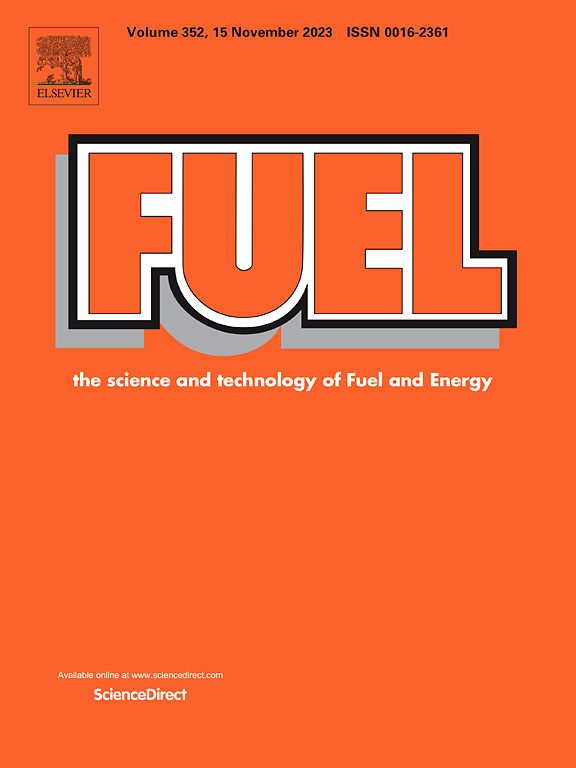绿色合成高效稳定的Ni@CQD纳米颗粒:二甲基氨硼烷和硼氢化钠水解制氢的实验和理论方法
IF 7.5
1区 工程技术
Q2 ENERGY & FUELS
引用次数: 0
摘要
本研究合成了Ni(0)、Ni@Urea、Ni@DOT、Ni@MOF-DOT四种不同的催化剂。其中前两种是用浸渍法合成的,后两种是用水热法合成的。以硼氢化钠(SBH)和二甲基胺硼烷(DMAB)为氢源,研究了催化剂的氢效率。最佳催化剂Ni@MOF-DOT对SBH和DMAB水解的HGR值分别为1423和642 (mL/min.g.cat), TOF值分别为191/hour和78.6/hour。利用透射电镜(TEM)、能量色散x射线能谱(EDS)、氮吸附/解吸、x射线衍射(XRD)、傅里叶变换红外光谱(FTIR)、电感耦合等离子体发射光谱(ICP-OES)和x射线光电子能谱(XPS)等分析手段对Ni@CQDs纳米催化剂进行了表征研究。在Arrhenius方程和eying - polanyi方程驱动的动力学分析中,催化剂在DMAB的水解中具有较低的活化参数,并且催化剂在两种氢源中均表现出超过6次可重复使用循环的稳定性。此外,(Ni@DOT-MOF)纳米催化剂的平均粒径约为4.6 nm, XPS和ICP分析证实其结构中存在碳(C)、氧(O)、氮(N)和Ni (Ni)原子。Ni@MOF-DOT催化剂中Ni原子的2P1/2和2P3/2自旋态的高密度产生了路易斯酸区,提高了催化活性。基于扩展紧密结合密度泛函理论(GFN1-xTB)的分子动力学(MD)结果支持了实验结果。本文章由计算机程序翻译,如有差异,请以英文原文为准。
Green synthesis of highly efficient and stable Ni@CQD nanoparticles: Experimental and theoretical approach for hydrogen production from dimethyl aminborane and sodium borohydride hydrolysis
In this study, four different catalysts (Ni(0), Ni@Urea, Ni@DOT, Ni@MOF-DOT) were synthesized. The first two of these were synthesized by the impregnation method, while the last two were obtained using the hydrothermal method. Hydrogen (H2) efficiency of catalyses were investigated by hydrolysing sodium borohydride (SBH) and dimethylamine borane (DMAB) hydrogen sources. The HGR values obtained for SBH and DMAB hydrolysis of the best catalysis Ni@MOF-DOT were determined to be 1423 and 642 (mL/min.g.cat), and the TOF values were determined to be 191/hour and 78.6/hour, respectively. Transmission Electron Microscopy (TEM), Energy-dispersive X-ray spectroscopy (EDS), nitrogen adsorption/desorption, X-ray diffraction (XRD), Fourier transform infrared spectroscopy (FTIR), Inductively coupled plasma optical emission spectroscopy (ICP-OES) and X-ray photoelectron spectroscopy (XPS) analyses were used for the characterization study of Ni@CQDs nano-catalyst. In kinetic analyses driven by Arrhenius and Eyring-Polanyi equations, the catalyst in the hydrolysing of DMAB has lower activation parameters while the catalysts have showed stability over six reusability cycles in both hydrogen sources. Also, the average particle size of the (Ni@DOT-MOF) nano catalyst is about 4.6 nm and the presence of Carbon (C), oxygen (O), nitrogen (N) and Ni (Ni) atoms in its structure is confirmed by XPS and ICP analyses. The high density of 2P1/2 and 2P3/2 spin states of Ni atoms in the Ni@MOF-DOT catalyst creates Lewis acid regions that increase the catalytic activity. The experimental results were supported by Molecular Dynamics (MD) findings based on extended tight-binding density functional theory (GFN1-xTB).
求助全文
通过发布文献求助,成功后即可免费获取论文全文。
去求助
来源期刊

Fuel
工程技术-工程:化工
CiteScore
12.80
自引率
20.30%
发文量
3506
审稿时长
64 days
期刊介绍:
The exploration of energy sources remains a critical matter of study. For the past nine decades, fuel has consistently held the forefront in primary research efforts within the field of energy science. This area of investigation encompasses a wide range of subjects, with a particular emphasis on emerging concerns like environmental factors and pollution.
 求助内容:
求助内容: 应助结果提醒方式:
应助结果提醒方式:


